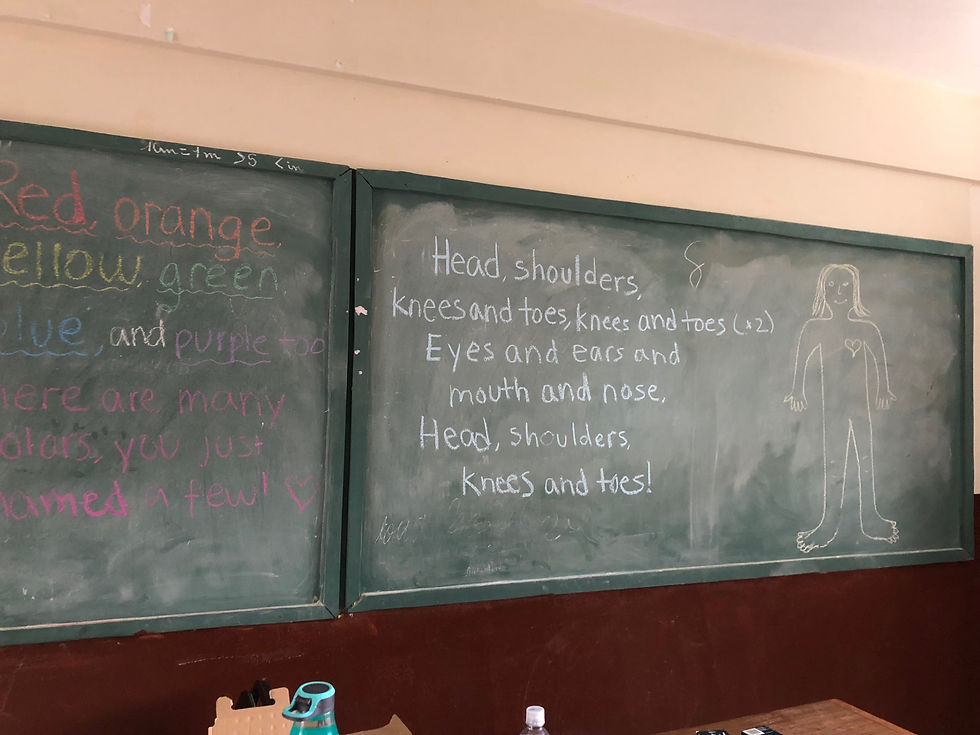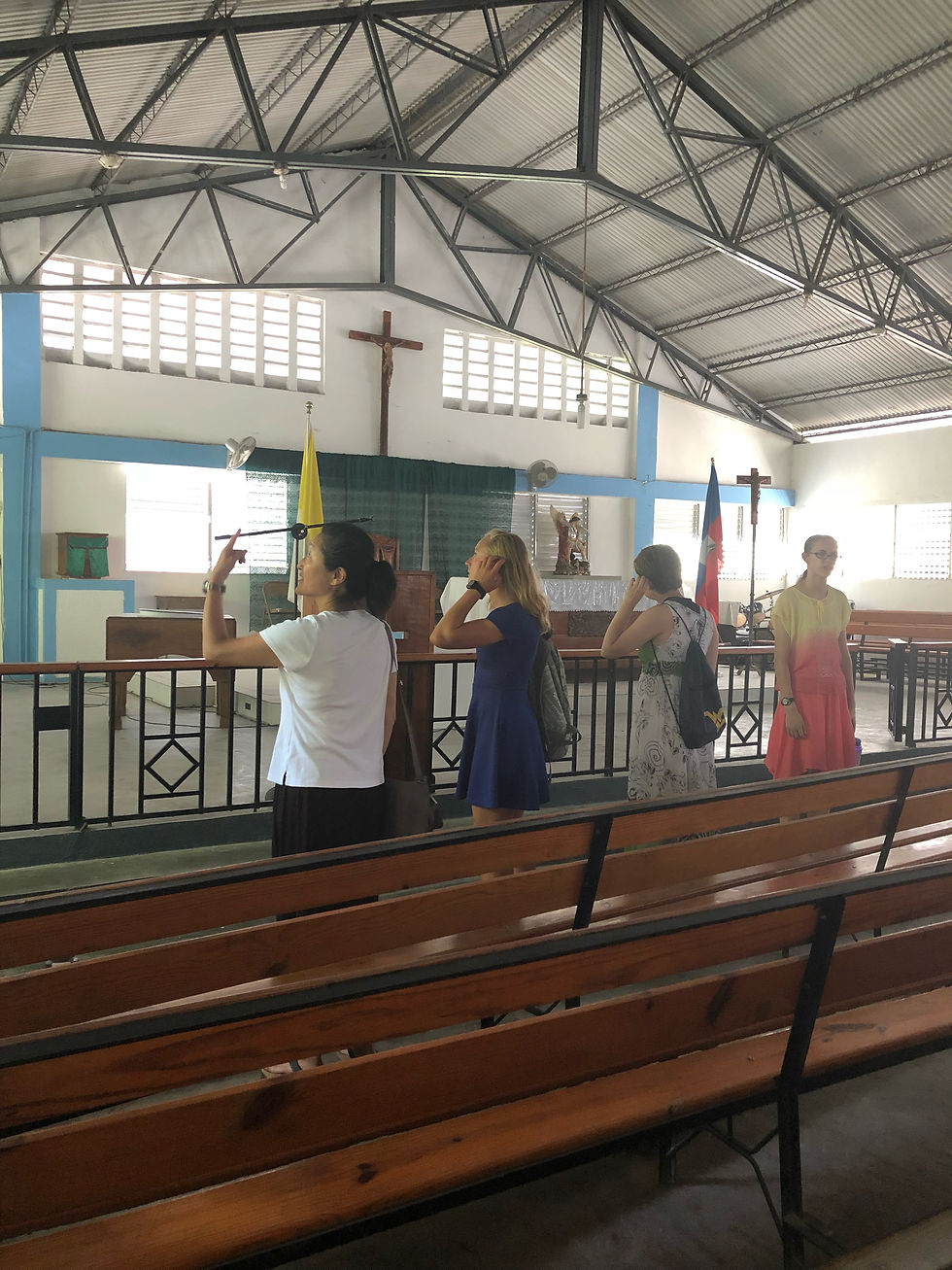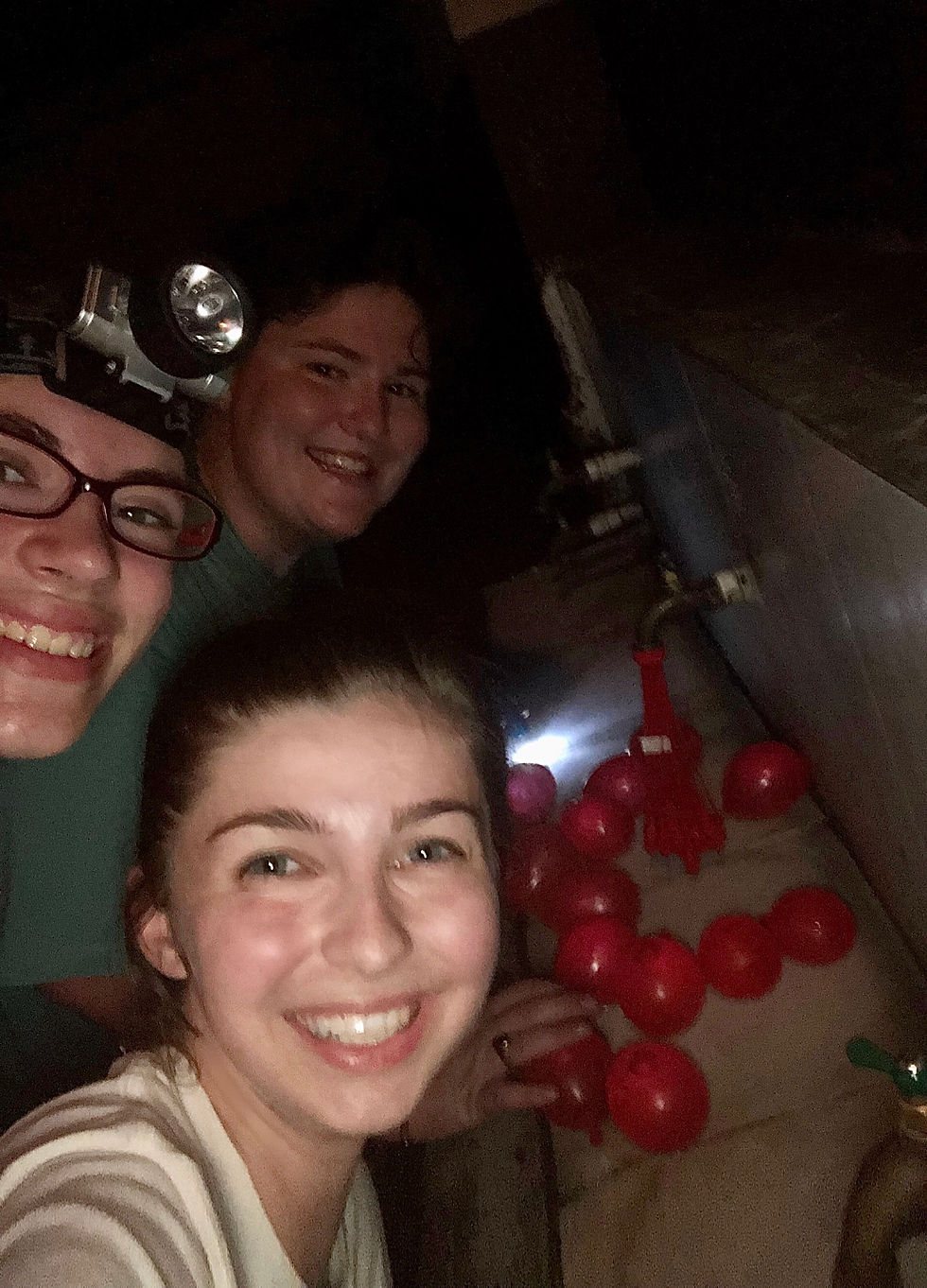Day 3
- Brooke Nixon

- Jul 13, 2020
- 7 min read
Updated: Jul 13, 2020
Serving in Haiti: A Day in the Life
Today’s blog is a day in the life of being on the mission trip. Since today is Day 3 of our campaign, I chose Day 3 in Haiti (Wednesday, July 3rd) to base it on.
7:00-7:15 a.m.: I wake up. I slept fairly well last night compared to the other nights. One thing I wasn’t expecting here was how loud the surrounding areas could get at night. It seems as if "Despacito" plays on constant repeat with Haitians talking and laughing outside until sunrise. Although I can’t understand most of what they say, I hear many laughs. “Happy as a Haitian” is becoming one of my new and favorite phrases.
Julia, one of my roommates, is already awake, dressed, and putting on sunscreen. I wish I were as much of a morning person as she was. In the bed next to her, Olivia is also still in bed, but awake. We get up, get dressed, and head downstairs for breakfast.
7:30: The kitchen is bustling with the 13 of us on the trip coming in and out, grabbing food quickly then racing to set up our stations so we can get some time to play with the kids as they arrive. Every morning, I had some combination of bananas, peanut butter, and bread for breakfast. I fill up my water bottle almost entirely with ice, even though there’s not much point to that. The sun and July heat are unforgiving, and there is no air conditioning. The classrooms are all on open balconies for ventilation, but that does little to stop the heat from coming through.
7:45-8:05: Olivia and I go to set up our classroom. We’re at the English station today and very excited for it. After receiving our assignment the night before, we made lesson plans and came up with ideas for teaching. Our plan is to tackle parts of the body, colors, and animals. Considering we speak almost no Creole and the children speak very little English, the station is the most challenging but also most rewarding. We write the lyrics to “Head, Shoulders, Knees, and Toes” on the board, a poem about colors, and some animal sounds. Once we are finished, we head downstairs into the courtyard to play with the kids.

8:30: Rachel (our trip leader) calls out something in Creole, and all the children immediately drop what they are doing, get in two even lines, bow their heads, and pray. They pray reverently, hands folded, eyes shut, in song, in word, and in call and response. The sight is one of the most moving things I have seen on the trip, and you can watch a video of it under the “photos” section of the site.
8:45- 12: Camp begins. We lead the first group of campers (usually about 15-20) upstairs to the English classroom with us. We start off with some basic English phrases that are drilled into their minds during the year. “Good morning everyone,” Olivia starts. “Good morning,” they reply immediately. “How are you?” I ask. “Very good AND you!” the kids chorus back pridefully. It is clear they are not quite sure what they are saying, but they have the sounds memorized. The “and” in their response was always particularly emphasized.
We do our best to teach with charades, pointing, and call and response. “Red,” we say, pointing to red on the board and holding up red chalk. “Red,” they repeat back with a heavy, exaggerated sound. But by the time we get to yellow and try to go back to red to see if they retained it, we get an “ed” response from some and blank looks from others. The animals go a little bit better. Olivia and I make complete fools of ourselves trying to act out an animal while making the sound to see if it will click. “Woof woof,” Olivia says, as I crawl on the ground trying to act out a dog.
The kids laugh.
“Dog,” I say standing up, “woof woof.” “Dog,” they repeat back, woofing, too. Olivia and I smile at each other, hoping some of this will be retained. What was funny about this exercise was that for some reason “snake” was hilarious to the kids. “Snake,” we said, “ssssssss,” making a slithering sound and motioning with our arms a snake moving on the ground. For the rest of the week, kids would run up to us and gleefully say, “ssssss – snake!” before running away again.
Next was “Head Shoulders, Knees, and Toes.” We sang it, one line at a time, pointing to the correct part of the body. They stood up and did the same. They seemed to really like the song, so we spend the bulk of our time on it. By the end, the first line seems pretty well retained. The words of “eyes, and ears, and mouth, and nose” are a little messy, but they can get through the song themselves with little help.

Singing "Head, Shoulders, Knees, and Toes" at the end of the camp day.
Three stations at an hour each with no breaks both fly by and stretch on. But at the end of each, the kids jump up gleefully, give us hugs, and repeat whatever English word or phrase stuck out to them from the hour of teaching before heading to the next camp station. My heart is filled with happiness, and I hope that it can be the beginning of a foundation of the English language for them.
12:00: Normally, we played with the kids for a while before lunch and then went on an excursion. Today, however, we had to get changed quickly to drive to our first location. Since there were a few stops on it, I’ll give just the highlights here.
First, we went to a sister parish in Haiti. They gave us a tour, and we ate lunch there. One of the sweetest things about this particular stop was that the people there knew we were coming and set out American delicacies for us to eat — things such as cookies and Pringles that are not common snacks there. The gesture was so meaningful.

We also toured their preschool/grade school. Thinking it would be similar to Les Bons Samaritans, I had to work to keep the surprise off my face when we saw a giant warehouse-type building with classrooms separated only by wooden barriers and chicken wire.
It certainly was not a set up ideal for education, and I was again reminded of just how blessed I was to grow up (1) being able to attend school and (2) going to schools that had classrooms separated by walls. Outside, there was a beaten down swing set and small patchy field for recess and play time: a sharp contrast to the four-part playset I spent my recesses playing on while growing up.

The school classrooms and the playground/recess area.

Next, we toured the most advanced hospital in Haiti. In a meeting prior to the trip, I remember the leaders saying how we were very close to the most “state-of-the-art” hospital in Haiti, so if anything happened, we would have access to good medical care. In my head, that meant maybe the hospital wouldn’t be a Johns Hopkins type of establishment, but maybe more comparable to one of the local, smaller hospitals.
When we first started the tour, my heart jumped to my throat and remained for the duration. Their waiting room consisted of an outdoor pavilion. There were few rooms or even curtains for privacy, and I felt so much guilt for walking around, making direct eye contact with very sick and gaunt patients lying out in giant, open rooms lined with gurneys. There was dried blood on the floor. Doctors and nurses were spread sparsely around the hospital.
It was quite a far sight from Johns Hopkins, a local hospital, or even local clinics in the U.S.
That night, tears fell as I wrote in my journal, “How many of the people that I saw in the hospital will die from things completely preventable just because of their geographical location? Things that, in the U.S., could be solved in a matter of hours or days? The world presses on to find the newest and best medicines and cures without even ensuring all people in the world can access those treatments... it’s not right.”
5:30 p.m.: Return to the school. Get changed and set the table for dinner. A local Haitian who stayed in the school cooked all of our meals for the week, and they were delicious. Many were traditional Haitian meals, and rice and fried plantains were featured frequently among other food. We all ate together and often talked about what happened that day. We received assignments for what the next day’s stations would be, so we could plan. I learn I will be in outdoor games with Julia and Ty the next day.
6:30: Plan for camp the next day with our partners/groups. We decided to play with water balloons for outdoor games. This would become one of my favorite memories of the whole camp.
7:15: Journaling, reflecting, resting, showering. Like I mentioned before, there was no AC in Haiti, and the heat was relentless. Even though there wasn't hot water for showers, cold showers provided a relief from the evening heat making them a highlight of the day.
8:30: Julia, Ty, and I fill up tons of water balloons in preparation for the next day using an outdoor sink near the courtyard.

9:00: Each night was a little different. Sometimes we did more in-depth group reflection or study, sometimes we read or played games, sometimes we all just sat in a room and talked. My group got very close, very quickly, and I am grateful for that. One of our favorite things to do was play the card game Uno at the kitchen table. It became very intense by the end, and I have pictures timestamped after 1 a.m. playing. It was hard to sleep most nights because of the heat, new surroundings, and loud noise outside. In hindsight, I am grateful for this as it allowed more opportunity for reflection and bonding with the rest of the group.
Our days were busy, rewarding, and sometimes emotional rollercoasters. But our time spent in Haiti was invaluable, especially the moments that shocked us and put our lives and hardships into perspective. No, we should not feel guilty for what we have. We didn't earn the lives we were born with, but we didn't take those lives from the people we met, either. Haiti taught us that the privilege in our lives can be used for the good of others. We can give from our own good fortune to those who have it so much harder than us.
To donate, click here or visit the "donate" tab.



Comments